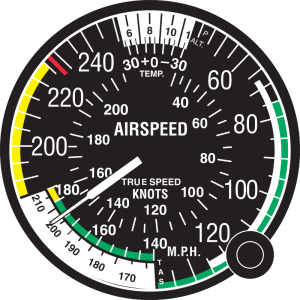
Airplanes have their own speedometers to measure the speeds at which they fly. Known as an airspeed indicator, it’s a flight instrument found inside the cockpit. Pilots can refer to the airspeed indicator to determine their airplane’s speed. Using this information, pilots can accelerate or decelerate.
#1) Knots Is the Most Common Unit of Measurement
Most airspeed indicators display the speed at which airplanes fly in knots. The adjacent photo, for instance, depicts a typical airspeed indicator with knots as the unit of measurement. Some airspeed indicators use an alternative unit of measurement, such as km/h, mph or m/s. Nonetheless, knots is the most common unit of measurement for airspeed indicators.
#2) Shows Pressure Differences
Airspeed indicators show more than just the speed at which airplanes fly; they show pressure differences. More specifically, they show the difference between the airplane’s static pressure — the pressure from the airplane’s static ports — and the airplane’s ram pressure. By understanding the difference between the airplane’s static pressure and ram pressure, pilots can gain a better understanding of their available lift.
#3) Uses a Color-Coded Design
Airspeed indicators are color-coded. They feature various markings in specific colors. Green markings indicate a normal operating range. White markings, on the other hand, indicate the flap operating range for landings and approaches. Yellow markings indicate caution. And the red line indicates the point of failure. With their color-coded design, airspeed indicators are easy for pilots to use.
#4) Not the Same as Vertical Speed Indicators
While they are both speed-based flight instruments, airspeed indicators and vertical speed indicators aren’t the same. Vertical speed indicators show the speed at which an airplane climbs or descends. Also known as a variometer, it’s a flight instrument that lives up to its namesake by focusing on vertical speed. Airspeed indicators show the speed at which an airplane flies. There are other nuances between these two flight instruments, but vertical speed indicators focus on vertical speeds.
#5) Part of the Six Pack
Airspeed indicators are part of the six pack. The six pack refers to a half-dozen flight instruments that are displayed together. They include an airspeed indicator, an altitude indicator, an altimeter, a turn coordinator, a heading indicator and a vertical speed indicator. Many airplanes are designed with these six flight instruments. The airspeed indicator is an essential part of the six pack, as it reveals the speed at which airplanes fly.



